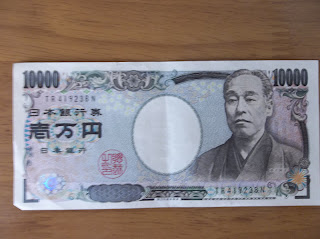Anyway.
The other day I learned from my Kindle version of the Oxford English Dictionary that the yen used to be divided into 100 sens, which I find very odd, since "sen" means 1000 in Japanese. But I learned in Wikipedia that 1/1000 of a yen used to be a rin. Both these denominations were taken out of circulation in 1953, though, and now it's only the yen.
Here are some pictures of my Japanese monies. The bills are funny because they have a semi-empty oval in the middle (there's a watermark portrait), which says to me "Your face here."
Nice hair.
By the way, there's also a ¥2000 bill, and I got like three of them from Bank of American when I exchanged money before I came over here, but I didn't take a picture. As I later found out, this denomination is actually somewhat rare, though perhaps not as rare as the American $2 bill, and when I used them, people were quite surprised.
Japanese monies are cool because the coins are all different textures, sizes, and weights, so they're easy to distinguish, even for blind people. The bills are also sized differently, which benefits the blind, and the colors are all different, too. We could learn something from this.
Japanese monies are not cool because the coins go up to such a high value, and the bills only start at a high value, which means I've got to carry around a stupid change purse, a lot of my transactions are solely coin-based, and I also feel slightly nervous about losing valuable change.
Between the early 1990s and the late 2000's, the yen ran at typically around 100 yen per US dollar (sometimes getting up to like 125, though), which made conversion a pretty simple matter. Since the end of '08, though, the yen has been getting stronger in comparison with the dollar, and has been running in the high 70's to low 80's range, which involves slightly more math to convert, but which benefits me greatly. Now when I transfer money home, instead of getting about $4000 for ¥400,000, as I would have a few years ago, I get about $5000. It's totally suite.
But you can see how it's a bit of a concern to have a coin that's worth over six bucks, and not have any paper money worth under twelve bucks. But I guess it's okay. People seem to be pretty patient at the store if I need to carefully count out a dozen coins onto the tray.








No comments:
Post a Comment